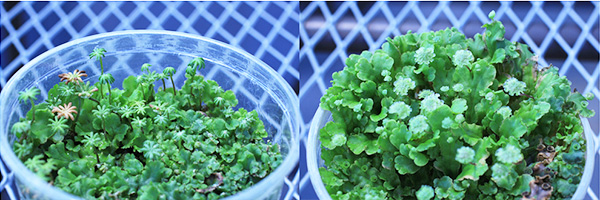
Professors Kohchi (left) and Araki
Recent advances in bioscience have been made possible by the use of model organisms, examples of which include Escherichia coli , hay bacillus ( Bacillus subtilis ), yeast, fruit flies, nematodes, zebrafish, and mice, as well as plants such as Chlamydomonas reinhardtii , thale-cress, and spreading earthmoss ( Physcomitrella patens ). With most of such organisms, research models have been established overseas, with only a handful, including killifish, associated with Japan.
Marchantia polymorpha , also known as the common liverwort or umbrella liverwort, is currently attracting attention as a useful model for research on evolutionary developmental biology of terrestrial flora.
Liverworts, which are the basalmost lineage of land plants, spend most of their life cycle as a haploid (n) gametophyte, allowing for easy isolation of mutants. In addition, they are dioecious and can easily be crossed, and produce a large quantity of genetically distinct spores by meiosis. These factors make them highly suitable for genetics research. Furthermore, their mode of reproduction lends to experimental biology approaches, while their body plan, which is simple but shares basic characteristics with crops and other terrestrial plants, is amenable to experiments in genetics and molecular biology. These are some of the features that make Marchantia polymorpha a simple and easy-to-handle land plant model.
The common liverwort is widely distributed across the world. In Europe, it has been extensively studied and used for education since the 19th century, with books devoted to the subject published during World War II. Interest then waned and remained low for some time, until Kyoto University researchers discovered the plant's utility in molecular biology research. In 1986, working with cultured cells, those scientists sequenced Marchantia 's chloroplast DNA, making it one of the two plant species whose chloroplast DNA was sequenced that year, the other one being tobacco. A comprehensive picture of the genes encoded in Marchantia 's chloroplast genome was thus revealed, as was the degree of conservation of those genes. Later, in 1992, the plant's mitochondria DNA was also sequenced, again from cultured cells. The liverwort's nuclear genome, estimated to be around 280Mb in size, is also being sequenced. As for chromosomes, Marchantia polymorpha has been found to have eight autosomes and a single sex chromosome (X in female and Y in male); in 2007, the liverwort's Y chromosome became the first plant chromosome to have its gene organization fully elucidated.
It has also been discovered that, reflecting its phylogenetic position, Marchantia polymorpha shares some of its core gene sets with algae as well as with other land plants. Its genome, meanwhile, can be easily and quickly edited using today's advanced tools; the common liverwort is now one of the easiest plants on which to perform transgenesis and gene function analyses. Thanks to these characteristics, Marchantia polymorpha is gaining popularity as a model for investigating the evolution of plants.
Against this backdrop, Professors Takayuki Kohchi and Takashi Araki of Kyoto University Graduate School of Biostudies (GSB) have recently undertaken the following projects, with funding provided by the Ministry of Education, Culture, Sports, Science and Technology (MEXT) in the form of a Grant-in-Aid for Scientific Research on an Innovative Area ("Multidimensional Exploration of Logics of Plant Development").
- 1st International Marchantia Training Course at GSB
From 25 February to 7 March 2016, eight researchers from UK, Germany, Spain, China, and Japan delivered special lectures and provided training in genomic, genetic, and gene analyses, and microscopic observation. - Plant and Cell Physiology 's Special Focus Issue on Marchantia polymorpha
Professors Kohchi and Araki, together with Dr John L Bowman of the School of Biological Sciences, Monash University, Australia, edited a Special Focus Issue of Plant and Cell Physiology , an international journal published by the Japanese Society of Plant Physiologists, pertaining to Marchantia polymorpha . Dated February 2016, this issue chronicled the history of Marchantia as a model organism and presented the latest molecular genetic tools available for working with it, while also examining historical illustrations of the liverwort's developmental process, and presenting an explanation of terminology, a community-led recommendation for gene nomenclature, and innovative studies utilizing the species.
Professor Kohchi and Dr Bowman also co-authored an article about the plant for the 7 March 2016 issue of another international journal, Current Biology , together with Dr Fred Berger of the Gregor Mendel Institute of Molecular Plant Biology (GMI), Austria.
The common liverwort has come to be viewed by many as an ideal model for understanding plants' evolutionary diversity and for investigating terrestrial flora's control logic, which is common across angiosperms, including many crop varieties. After being used in scientific observations and experiments for more than two centuries, Marchantia polymorpha has recently emerged from Kyoto as a model organism of choice for molecular genetics and genomic biology, a development widely hailed as a renaissance for Marchantia research.

Female (left) and male plants of Marchantia polymorpha . Takaragaike and Kitashirakawa strains, the latter of which was harvested from the Kyoto University Botanical Garden, are internationally recognized as standards.





